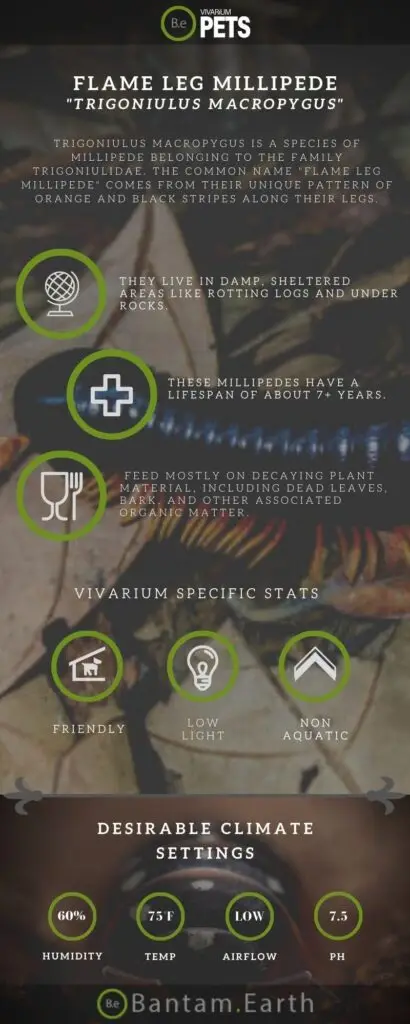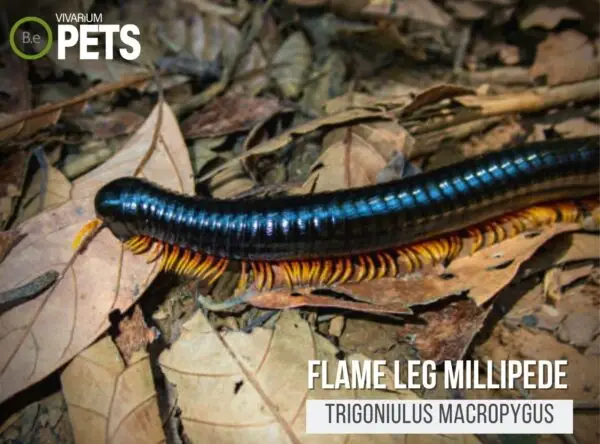The Flame Leg Millipede (Trigoniulus macropygus) is an interesting catch to have as a pet and I’m here to help you properly care for it!
Keep reading for our comprehensive guide on caring for this unique species.
With its stunning colors, sweet demeanor, and manageable care needs, the small millipede is an ideal critter for both first-time owners and experienced keepers alike.
Table Of Contents:
ToggleWhat Are Flame Leg Millipedes?
Trigoniulus macropygus is a species of millipede belonging to the family Trigoniulidae.
They are found in moist deciduous forests in the Philippines but have also become popular in the pet trade.
The common name “Flame Leg Millipede” comes from their unique pattern of orange and black stripes along their legs.
Create an ideal habitat for your millipede with our Customizable Millipede Enclosure Kits, which include everything you need to get started.
What Do Flame Leg Millipedes Look Like?
The Flame Leg Millipede is easily identifiable by its deep orange, red, and yellow legs.
Its unique yellow legs and antennae provide a contrast to the dark contrast of its body, making it a very attractive species.
Measuring up to 5 cm in length, Trigoniulus macropygus is one of the mid-sized species of millipedes available as a pet.
Like all millipedes, their body consists of many segments, each of which is covered with a protective exoskeleton.
The head of the millipede contains two simple eyes and two antennae with which the millipede can smell and feel its environment.
Along its back, the millipede has 2 to 4 pairs of legs per segment, with an even number of legs overall.
Its main defenses are a pair of pincers at the front of its head and the ability to secrete noxious chemicals to ward off predators.
Benefits Of Using Flame Leg Millipedes
Flame Leg Millipedes add an extra level of color and interest to terrariums and paludariums, making them ideal for hobbyists who want to create beautiful displays.
They actively help to keep substrates clean by consuming decomposing food and dispersing it throughout the enclosure.
This helps to keep the environment healthy and thriving and helps to promote microbial balance.
Additionally, Trigoniulus macropygus helps to aerate the soil, by creating tunnels in the substrate.
Finally, their shy and docile nature makes them great pets for people of all ages and experience levels.


Flame Leg Millipede Facts
The Flame Leg Millipede is a bright, lively species native to the Philippines.
With golden-hued legs and unique coloration, these millipedes are a favorite among exotic pet enthusiasts.
They are not particularly challenging pets, but they must be provided with the right temperature and humidity levels to thrive.
Flame Leg Millipedes are herbivorous and eat a variety of leafy greens and fruits.
Their lifespan is typically 2+ years, and they reproduce quickly under the right conditions.
Habitat
Trigoniulus macropygus is a species of millipede found in tropical forests throughout Southeast Asia and the Philippines.
They live in damp, sheltered areas like rotting logs and under rocks, where they can access the food and water sources that are necessary for their survival.
Their natural habitat is typically warm, humid, and dark and has plenty of decaying vegetation for them to scavenge through.
In the wild, Flame Leg Millipedes are most often seen when the rain washes them out of their hiding spots and exposes them for a brief time.
They can often be seen in large groups, where they form a collective, writhing mass on the forest floor.
Replicate their natural habitat perfectly with our Bioactive Millipede Substrate Blend, designed to provide the ideal moisture and organic content for your millipedes.
Diet
Flame Leg Millipedes feed mostly on decaying plant material, including dead leaves, bark, and other associated organic matter.
In the wild, they often act as nutrient recyclers, breaking down the material that would otherwise remain in the environment.
In addition to a varied diet, Flame Leg Millipedes also benefit from occasional treats of decaying insects and other animal matter.
This can help introduce needed calcium and trace elements into their diet.
Temperament
The Flame Leg Millipede is generally not an aggressive species and can be quite friendly when handled properly.
They have an inquisitive nature towards humans and generally become accustomed to their environment and owners with gentle handling.
While they will not normally bite or sting, they can produce a defensive liquid that should be handled with caution as it can irritate when it comes in contact with skin or eyes.
Due to their mellow nature, they can make good companions to other animals of similar sizes.
Lifespan
Trigoniulus macropygus has a life expectancy of about two years. As juveniles, they are quite small measuring only about 1.5–2 cm in length.
They grow very slowly and typically reach their full adult length of 5 cm after their first molt.
Although they grow slowly, they molt more frequently than other species of millipedes, shedding their exoskeleton up to 8 times a year.
Millipedes have an interesting life cycle. Females lay their eggs in the soil, and in 3-4 weeks, the eggs hatch.
The millipedes develop in 5-6 stages, each time shedding their skin (molting) and growing larger until they reach adulthood.
These stages last a few weeks each and are triggered by environmental factors such as temperature and humidity.
Breeding
Flame Leg Millipedes can require quite a bit of care when it comes to mating and reproduction.
These millipedes typically reproduce during the fall, winter, and spring seasons.
Before reproduction takes place, the millipedes must be well-fed and in the proper environment.
After mating, the female will lay her eggs in the soil, which will take about two to three weeks to hatch.
Once the eggs hatch, the young millipedes must be given plenty of food, moisture, and a warm environment to thrive.
Where To Find Flame Leg Millipedes
If you are interested in finding Flame Leg Millipedes in the wild, be sure to do your research first on the environment and climate of the area.
Trigoniulus macropygus prefers moist, semi-shaded forests and mountainous environments.
In some countries, it is illegal to take these millipedes out of their natural environment- so be sure to stay on the right side of the law!
Flame Leg Millipedes can be found for sale in many pet stores and online retailers around the world.
Be sure to do your research on the seller before you purchase, to guarantee the health and safety of your new pet.
Finding a seller who has experience in caring for millipedes is essential if you’re looking for success as a millipede keeper!
Flame Leg Millipede Care
Caring for Flame Leg Millipedes is a straightforward process.
They require a warm, humid enclosure with the right substrate, water, and food to keep them healthy.
They do best when kept at temperatures between 75°F and 80°F and with a humidity of about 80%.
They should also be provided with calcium and mineral supplements to aid in their development.
Tank Requirements
Trigoniulus macropygus requires an enclosure that is ideal for maintaining adequate humidity levels.
A terrarium or paludarium with a screened lid is the best option, providing enough ventilation while still keeping the humidity high.
The tank should have a minimum of 10 gallons of space and be filled with half an inch to one inch of substrate.
The ideal terrarium substrate for the Flame Leg Millipede is coconut fiber, peat moss, and leaf litter mixed.
The enclosure should also be filled with items for hiding, such as branches, logs, or cork bark.
The ideal pH for the Trigoniulus macropygus is roughly 6.2 to 6.7, with a hardness of approximately 1-5 dH.
For nighttime temperatures, keep it at 72-73 degrees Fahrenheit.
For optimal health, add a submersible heater and guide the temperature and humidity with a thermometer and hygrometer.
A scheduled terrarium light that runs on day/night cycles is also recommended to provide the millipede with a natural light cycle.
What Do Flame Leg Millipedes Eat?
Feeding a Trigoniulus macropygus is easy. They are primarily herbivores and will happily munch on various fruits and vegetables.
Some of the most popular Flame Leg Millipede treats include sliced apple, carrot, and sweet potato.
You should also offer a variety of leafy greens such as kale, spinach, and lettuce.
Additionally, provide calcium supplements, which can be placed in the enclosure for your millipede to snack on.
Lastly, Flame Leg Millipedes love rotting logs and bark, so provide some of those for them to explore and forage for food.
If you’re more of an avid hobbyist like myself, check out my ultimate DIY Millipede food guide. I explain the best foods and my favorite recipe in more depth.
Best Tankmates For Flame Leg Millipedes
The Flame Leg Millipede is most content when living harmoniously with other species.
Not all animals will make for suitable tankmates, however.
Trigoniulus macropygus should only be kept with peaceful species that do not pose a risk of harm.
Isopods such as the Cubaris species, sow bugs as well as pill bugs can make great companions.
These humble critters are small and active and will provide entertainment for the Flame Leg Millipede.
Finally, springtails can also make for great tankmates. These creatures are slow-moving, and their soft bodies are unlikely to hurt Trigoniulus macropygus.
Conclusion
With the right setup, food, and care, these millipedes can thrive in captivity and become amazing pet millipedes.
Keeping a Trigoniulus macropygus is a rewarding experience that all levels of pet owners can enjoy.
Hopefully, with this guide, you can now confidently bring home and care for your own Flame Leg Millipede.
Create the ideal habitat for your millipedes with our species-specific soil mixes and Insect Enclosure Kits. These products provide everything you need for a successful and thriving millipede colony.
Frequently Asked Questions
Trigoniulus is a genus of millipedes in the family Trigoniulidae. The name Trigoniulus is derived from the Greek words “trigono” meaning “triangle” and “ulus” meaning “small”, which refers to the triangular shape of the body segments of these millipedes.
The scientific name for the flame leg millipede is Trigoniulus macropygus.
The price of a flame leg millipede may vary depending on factors such as its size, rarity, and location of purchase. It’s always advisable to purchase animals from reputable and licensed breeders to ensure their health and welfare, as well as to comply with local laws and regulations.
Flame leg millipedes (Trigoniulus macropygus) typically grow to a length of up to 1.6 inches in length.







